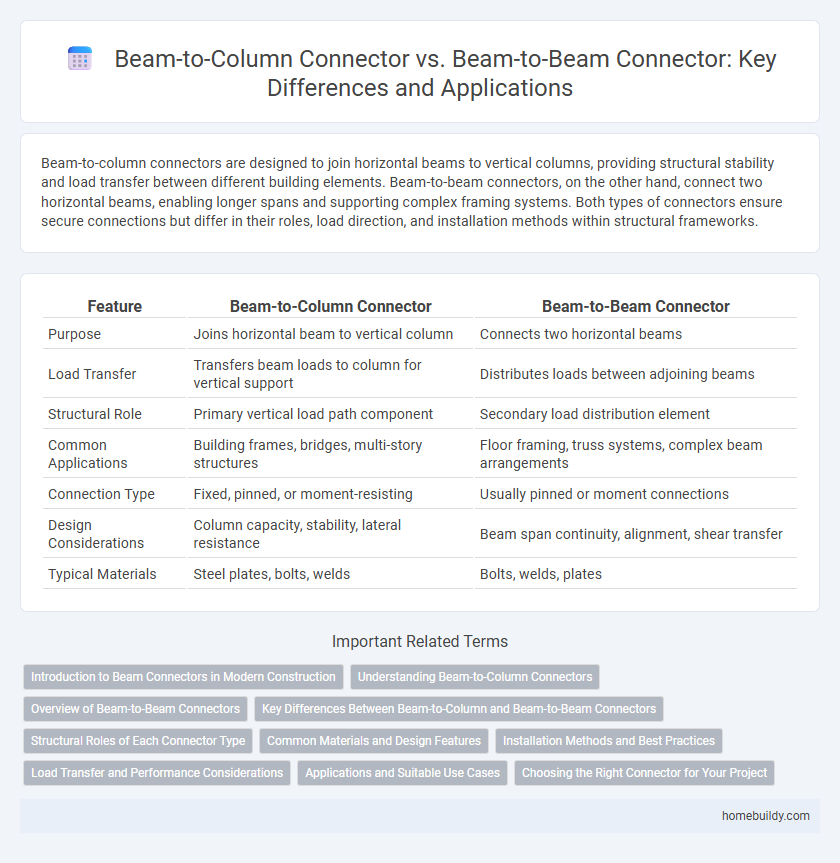Beam-to-column connectors are designed to join horizontal beams to vertical columns, providing structural stability and load transfer between different building elements. Beam-to-beam connectors, on the other hand, connect two horizontal beams, enabling longer spans and supporting complex framing systems. Both types of connectors ensure secure connections but differ in their roles, load direction, and installation methods within structural frameworks.
Table of Comparison
| Feature | Beam-to-Column Connector | Beam-to-Beam Connector |
|---|---|---|
| Purpose | Joins horizontal beam to vertical column | Connects two horizontal beams |
| Load Transfer | Transfers beam loads to column for vertical support | Distributes loads between adjoining beams |
| Structural Role | Primary vertical load path component | Secondary load distribution element |
| Common Applications | Building frames, bridges, multi-story structures | Floor framing, truss systems, complex beam arrangements |
| Connection Type | Fixed, pinned, or moment-resisting | Usually pinned or moment connections |
| Design Considerations | Column capacity, stability, lateral resistance | Beam span continuity, alignment, shear transfer |
| Typical Materials | Steel plates, bolts, welds | Bolts, welds, plates |
Introduction to Beam Connectors in Modern Construction
Beam connectors are essential components in modern construction, ensuring structural integrity and load transfer between different elements. Beam-to-column connectors provide critical support by fastening horizontal beams to vertical columns, enhancing stability and resistance to lateral forces. Beam-to-beam connectors, on the other hand, join horizontal beams together, facilitating extended spans and complex framing systems in building frameworks.
Understanding Beam-to-Column Connectors
Beam-to-column connectors are essential structural components designed to join horizontal beams to vertical columns, ensuring stability and load transfer in steel frame constructions. They accommodate various connection types such as moment, shear, and seated connections, each tailored to specific load requirements and structural behaviors. Proper understanding of beam-to-column connectors involves recognizing their role in resisting forces, allowing rotational movement, and maintaining the integrity of the building frame under dynamic and static loads.
Overview of Beam-to-Beam Connectors
Beam-to-beam connectors are engineered to join two horizontal structural members, facilitating load transfer and enabling complex frame configurations in steel or timber construction. These connectors are designed to accommodate varying angles and moments, providing flexibility and strength in mezzanines, trusses, and multi-span beams. Optimized beam-to-beam connections improve structural continuity and reduce the need for additional support elements, enhancing overall building efficiency.
Key Differences Between Beam-to-Column and Beam-to-Beam Connectors
Beam-to-column connectors primarily provide vertical load transfer and moment resistance between horizontal beams and vertical columns, ensuring structural stability and lateral support in building frameworks. Beam-to-beam connectors are designed for transferring shear forces and bending moments between intersecting beams, facilitating load distribution within the horizontal plane. Key differences include their load transfer mechanisms, connection orientation, and role in overall structural integrity.
Structural Roles of Each Connector Type
Beam-to-column connectors provide critical vertical load transfer from beams to columns, ensuring stability and supporting axial and shear forces within a building's framework. Beam-to-beam connectors primarily facilitate horizontal load distribution and moment transfer between intersecting beams, enhancing rigidity and structural continuity across spans. Each connector type plays a distinct role in maintaining the integrity and load path efficiency of steel or concrete frame structures.
Common Materials and Design Features
Beam-to-column connectors commonly use steel plates and bolts designed for high load transfer and moment resistance, ensuring stability in vertical and lateral loads. Beam-to-beam connectors often incorporate shear plates or end-plates with welds or bolts, focusing on shear transfer and alignment between horizontal members. Both connectors prioritize materials like high-strength steel and design features accommodating structural compatibility and ease of installation.
Installation Methods and Best Practices
Beam-to-column connectors are typically installed using bolted or welded methods, ensuring rigid structural support and alignment with the column flange or web, while beam-to-beam connectors often utilize clip angles or shear tabs for quick assembly and load transfer between beams. Precision in hole alignment and proper torque application during bolting are critical for both connector types to maintain structural integrity and prevent loosening under dynamic loads. Best practices emphasize using manufacturer-specified hardware, verifying weld quality through non-destructive testing, and coordinating with structural engineers to conform to load requirements and building codes.
Load Transfer and Performance Considerations
Beam-to-column connectors primarily facilitate vertical and lateral load transfer from beams to columns, ensuring stability under gravity and seismic forces, while beam-to-beam connectors handle moment and shear forces between beams, influencing structural continuity and flexibility. The design of beam-to-column connections typically emphasizes durability and resistance to cyclic loading, critical for overall frame stability, whereas beam-to-beam connections prioritize rotational capacity and displacement compatibility to accommodate beam deflections. Performance considerations for beam-to-column connectors involve load-bearing capacity and stiffness, whereas beam-to-beam connectors focus on transfer efficiency and allowing controlled deformation to maintain structural integrity.
Applications and Suitable Use Cases
Beam-to-column connectors are primarily used in structural frameworks where vertical load transfer and stability between horizontal beams and vertical columns are critical, such as in high-rise buildings and industrial structures. Beam-to-beam connectors facilitate horizontal load distribution and framing continuity, making them ideal for floor systems, roof trusses, and cantilevered structures. Selecting the appropriate connector depends on the structural design requirements, load types, and architectural configurations to ensure safety and performance.
Choosing the Right Connector for Your Project
Selecting the appropriate connector depends on structural requirements and load distribution; beam-to-column connectors primarily facilitate vertical load transfer and stability, while beam-to-beam connectors handle lateral support and moment connections between beams. Material compatibility, connector strength, and installation ease are critical factors influencing the choice to ensure safety and durability. Understanding project-specific demands and consulting engineering specifications ensures optimal performance and compliance with building codes.
Beam-to-column connector vs Beam-to-beam connector Infographic

 homebuildy.com
homebuildy.com